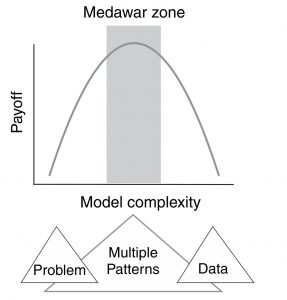Pattern-Oriented Modeling of Agent-Based Complex Systems: Lessons from Ecology
Grimm, Volker, et al. “Pattern-oriented modeling of agent-based complex systems: lessons from ecology.” science 310.5750 (2005): 987-991.
Grimm et al. set out to share their Ecological expertise in Pattern Oriented agent based Modeling (POM) with other fields. They establish credibility with the claim that more agent based modeling has been performed within the field of ecology than in all other field combined. The motivating principle of the POM concept is that Agent Based Models (ABMs) based on a single pattern observed a single scale or hierarchical level will not sufficiently limit uncertainty in model structure and parameters.
The authors explain that a model designed so that multiple observable patterns could emerge from it is more likely to fall in the area they refer to as the Medawar zone. This is the area of intermediate complexity where model “payoff” is highest. If model design is driven by one pattern (e.g. a single problem to be addressed) the model will be too simple and have limited use. If the model design is driven by all possible data the model will be too complicated and analysis will be difficult.
They also encourage employing multiple patterns in the use of “strong inference” on a set of potential ABMs. Many potential ABMs may reproduce a single focal pattern but far fewer will accurately produce a set of discrete observable patterns in a natural system. In this way the use of multiple patterns for model selection will improve the rigor of agent based modeling.
Finally, the authors argue first that the realistic structure of models designed as above with multiple patterns are likely to be less sensitive to parameter uncertainty. Failing that these multiple patterns can be used (similarly to point 2) as a way of fitting parameter sets within a chosen ABM. They argue that the “realism of structure and mechanism of pattern-oriented models helps parameters interact in ways similar to interactions in real mechanisms.” This concept seems implicit in their bottom-up modeling goals but I am unclear on how this makes model fitting any easier. Possibly this simply means that the parameters fitted are more likely to match those measured in the field/lab.
This paper is a strong argument for the use of multiple emergent patterns for the fitting of bottom-up agent based models and includes a large number of great examples (both ecological and not) that may be worth looking into.

